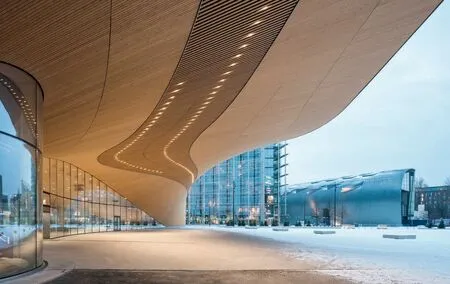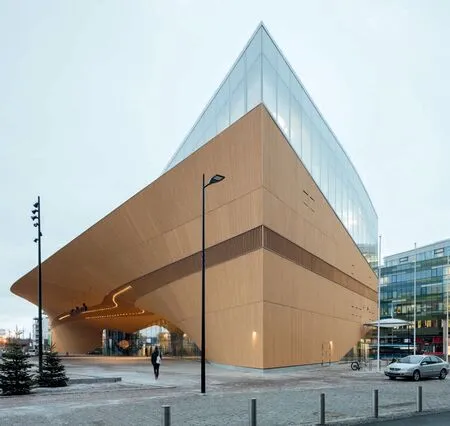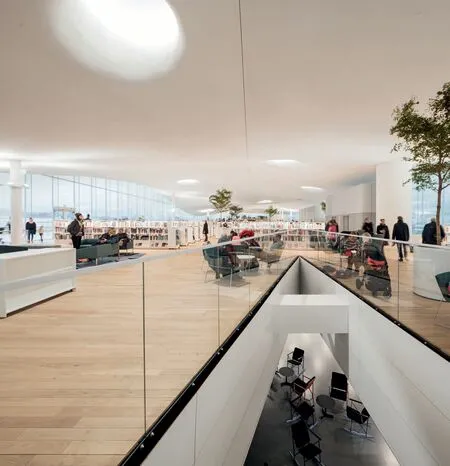赫尔辛基颂歌中央图书馆,赫尔辛基,芬兰
2020-02-08刘佳澳
(刘佳澳 译)

1 全景/Overall view
概念介绍
以赫尔辛基颂歌中央图书馆为代表,图书馆迎来了新的时代。这座位于赫尔辛基市中心的全新建筑包含了几乎所有的公共空间类型,并为市民提供各式各样的公共服务。开放一年以来,它已成为城市公共图书馆网络中令人印象深刻的新中心点。
图书馆的设计将功能主要划分为3个特质分明的区域:热闹活泼的首层、安静休闲的顶层和位于两层之间的为特定功能服务的补充层。设计将这种概念具象化为一个巨大的拱形结构,邀请人们来充分地使用拱形上下不同的空间,而由此产生的建筑结果成为了赫尔辛基和蝶略湖街区的城市生活中一个更为丰富的补充。
议会大厦街对面的市民广场一直延续到图书馆的拱形结构之下,这个灵活的公共空间适合举办各种类型的公共活动。首层的电影院和多功能厅既可以作为开放式大堂空间的一部分来使用,也可以各自分开以满足特定活动的需要。步行穿过一楼,可以快速地了解整个建筑的功能服务分区。在这层,雕塑般的木质表面从地面隆起,呈现出戏剧般的桥梁结构,这种创新的结构解决方案创造出了一个大体量的无柱空间,也最大程度地提高了建筑的可达性与辨识度。
位于顶层的“图书天堂”是一个巨大的开放式景观,顶部由如云朵般起伏的白色天花板装饰。在这里,由最新技术提供的可能性塑造出了现代图书馆的最佳特征——邀请使用者进行阅读、学习、思考和享受自我的宁静平和氛围。在这一层,人们也可以欣赏到360°无死角的城市景观。
中间层如“阁楼”一般,是位于桥梁桁架结构之间的空间,由灵活不规则形状的各功能房间与空间组成。封闭的空间形式旨在同时满足嘈杂与安静的活动需求。
通过直接开放向周边城市空间同时消解室内外区域的边界,建筑与整个蝶略湖区域相融合。大型门厅和由落地玻璃幕墙围合的多功能厅就如同室外公共空间在室内的延续。
拱形的木制体量在室外广场上空形成了一个巨大的遮蔽,营造出了一个大型的建筑灰空间,同时将建筑内部的功能延续到室外,如餐厅、咖啡店等。桥梁结构上方大型的公共露台使得图书馆使用者可以利用的户外公共空间增加一倍,也为人们聚会及鸟瞰观察城市生活提供了一个便利的场所。
建筑主要有3个公共入口:一个位于南面,主要服务于来自中央火车站的人流;一个位于市民广场旁边,在建筑物的西面;还有一个位于建筑的东北角,主要服务于电影院的使用者。
维护和图书馆的运输等后勤功能都位于图书馆的地下空间,在地上大众可到达的空间中尽量少的布置管理和储存空间,目的是为了最大化地将公共空间提供给图书馆使用者。图书馆的主要行政管理功能则保留在位于附近帕西拉街区的主图书馆中。
图书馆的运作在芬兰是有相关的法律规定与规范的,基本的图书馆服务都应该是免费的。这座新图书馆站在了城市图书馆服务更新的最前沿,除了核心业务外,图书馆还提供其他更为广泛的服务,例如赫尔辛基信息中心、欧盟相关信息中心、国家视听研究所的电影院等。新的图书馆每天都向公众开放,它成为了赫尔辛基大都市圈里最大的公共图书馆,同时也成为了大都市圈最受欢迎的公共活动空间。该图书馆每天都吸引9000名访客,总计吸引300万访客。
图书馆为蝶略湖街区创造出一个更加活跃和多样化的城市新环境。它为所有年龄段的人提供活动与体验,有足够的空间让人们可以聚集在一起共度时光而无需消费。图书馆使用者所扮演的角色从被动的媒体使用者转变为积极的参与者及内容制造者。作为一个非商业性的开放式公共空间,新的中央图书馆充当了赫尔辛基居民的公共客厅、工作室与书房。
技术特点
颂歌图书馆3层公共空间的概念通过一个横跨地面公共空间的超过100m的不对称桥梁结构来实现。钢桁架和钢梁组成的桥梁结构由两个巨大的钢制拱型结构支撑,这两个支撑同时又被钢筋混凝土楼板紧密地连结在一起。这种创新的结构解决方案既可以构建灵活的无柱内部空间,也为未来在现场下方建造隧道公路提供了便利。第二级钢桁架从拱形结构出发支撑悬臂式阳台和屋顶遮篷,形成独特的结构设计,以适应图书馆和公共区域的永久和临时功能。
颂歌图书馆使用在地材料建造,并考虑到当地的气候条件,其中木质立面贴材采用预制元素制成——33mm厚的芬兰高品质云杉。为达到复杂的曲面几何形状所需的精度,构件使用算法辅助参数化3D设计方法进行设计和制造。随着时间的变化,立面的颜色将朝着更深沉更丰富的原木色彩演变。
对幕墙性能的详细分析为环境解决方案提供了帮助,并使建筑能够最大限度地减少对机械环境控制系统的需求,这也使得高度灵活的建筑解决方案成为了可能。在公共区域,玻璃幕墙的使用为室内空间提供了更多的日光,减少了人造光的使用,从而提高了室内空间的使用质量。
精心规划的建筑功能布局和优化使空间布局具有灵活性。该建筑的所有公共楼层都可在150年的建筑使用寿命中进行功能更新与更改。
同时,图书馆非常节能,是近乎零能耗(nZEB)的建筑。这主要得益于建筑设备的能效。材料能效则主要得益于外表皮使用的木材。建筑信息模型被用于建筑与工程设计,以及检查设计兼容性,也被用于维护。□

2 西侧入口/West entrance
(刘佳澳 译)

3 面向市民广场旁边的西侧入口/West entrance of the building is next to the Kansalaistori Square
Architectural concept
Oodi represents a new era of libraries. The newly completed building at the heart of Helsinki consists almost entirely of public space and offers a wide selection of services. Having been open for a year, Oodi has already become the new central point for the city's impressive public library network.
The design divides the functions of the library into three distinct levels: an active ground floor, a peaceful upper floor, and an enclosed in-between volume containing the more specific functions. This concept has been developed into an arching form that invites people to utilise the spaces and services underneath, inside and on top of it. The resulting building is an inspiring and highly functional addition to the urban life of Helsinki and the Töölönlahti area.
The Kansalaistori square ("Citizens' Square") across the street from the Parliament House seamlessly continues inside the ground floor level of the library building. The flexible spaces are suitable for both small events and large happenings. The movie theatre and the multipurpose hall can be used as continuation of the open lobby space or separated off to cater for specific events. Walking through the ground floor offers a quick glimpse at the services available in the building. The sculptural wooden surface arches over the ground floor areas as a dramatic bridge-like structure. This innovative structural solution has enabled the creation of a column free public space to maximise the accessibility and visibility of the programme.
The "Book Heaven" on the top floor, is a vast open landscape topped with an undulating cloud like white ceiling. Here the best features of the modernist library meet the possibilities provided by up-to-date technologies. A calm, serene atmosphere invites visitors to read, learn, think, and relax. From this level visitors can enjoy an unobstructed 360-degree panorama view of the city centre.
The middle floor, the "Attic", consists of flexible irregularly shaped rooms, nooks and corners inhabiting the spaces between the trusses of the bridge structure. The enclosed spaces are designed to accommodate both noisy and quiet activities. The stepped seating in the open central area of this floor is the result of the form of the cantilevering, twisting west façade.
By opening directly to the surrounding cityscape and by dissolving the border between indoor and outdoor areas, the building engages directly with the Töölönlahti area. The large foyer and the glass-walled multi-purpose hall on ground level act as indoor extensions of the outdoor spaces.
The arching wooden volume creates an entrance canopy over the Kansalaistori square forming a covered outdoor space that expands the building's functions such as the ground level restaurant to the square. The large public terrace on top of the canopy doubles the amount of public outdoor space available for library visitors and creates a new destination where people can meet and observe the city below.
There are three public entrances in the building: one in the south for the main pedestrian flow from the direction of the Central Railway Station, one next to the Kansalaistori square to the west of the building shielded by the overhanging canopy, as well as one for the visitors to the movie theatre at the northeastern corner.
The spaces for maintenance and library logistics are located at basement level. The administration and storage spaces are kept to the minimum on the publicly accessed levels to maximise the open and accessible nature of the library. The administrative and storage functions of Helsinki Public Library remain at the main library in the nearby Pasila district.
Library operations are statutory in Finland. Basic library services are free of charge and freely available to everyone. The new library is at the forefront of the renewal of the city's library services. In addition to the core operations, there is a wide range of services available inside the building alongside an abundance of lounge spaces and auxiliary services that support the operations such as Helsinki Info - the City of Helsinki's information centre; Europa Experience - the centre for EU related information; and Kino Regina - the National Audiovisual Institute's movie theatre. In terms of services offered, the new library, a public space open seven days a week, is the largest public library in the Helsinki metropolitan area, and has also become the metropolitan area's most popular spot for returns and reservations. The library has attract 9000 visitors per day and 3 million visitors total.
The library has enlivened and diversified the new urban environment created in the Töölönlahti area. It offers activities and experiences for people of all ages. There are plenty of spaces that enable people to gather and spend time together, free of charge. The role of the library's clients has evolved from passive media users to active agents, participants and content producers. As a noncommercial open public space, the new Central Library acts as Helsinki residents' common living room, work space and learning environment.
Technical details
Oodi's spatial concept based on three individual public floors is executed by building the library as an inhabited, asymmetrical bridge spanning over 100 metres over the open ground floor. The bridge structure consisting of steel trusses and beams is supported by two massive steel arches, tensioned together with a reinforced concrete tension slab. The innovative structural solution has enabled both the construction of the flexible column-free interior spaces and the possibility for the construction of a future road tunnel under the site. Secondary steel trusses support the cantilevering balcony and roof canopy asymmetrically from the arch structure, forming a unique structural design to accommodate both permanent and temporary functions for both the library and the public realm.

4 外景/Exterior view

5 鸟瞰/Aerial view

6 分解轴测/Exploded axonometric drawing
Oodi has been built using local materials and with local climate conditions in mind. The wooden façade is made from pre-fabricated elements. 33-millimetre-thick Finnish spruce of high quality has been used for the cladding. A specific grading and quality control system was developed for the timber, the sawing and the treatment of the slats. The complex curved geometry was designed and manufactured using algorithm-aided parametric 3D design methods in order to achieve the required precision. The appearance of the façade will develop over the years towards a deeper, richer version of its initial hue.
The design of the building envelope is intrinsic to the passive energy approach adopted by the project team. Detailed analysis of the façade performance has informed the environmental solutions and has allowed the team to minimise the requirement for mechanical environmental control systems, which facilitates the highly flexible architectural solution. The glass façades allow for large amounts of functional daylight in the public areas, reducing the use of artificial light and enhancing the quality of the interior spaces as a multifunctional citizen's forum.
The carefully planned placement and optimisation of building services has enabled the flexibility of the spatial arrangements. All public levels of the building are equipped with access floors to allow for changes in use during the estimated 150-year life span of the building.
The library building is extremely energy efficient. Its energy consumption level is that of a nearly Zero Energy Building (nZEB). This is mostly due to the efficiency of the building services. The material efficiency of the building has benefited among other things from the use of wood in the exterior cladding. Building information modeling was used in both architectural and engineering design, as well as in checking the compatibility of the designs. Building information model will also be utilised for maintenance.□

7 剖面/Section

8 剖面/Section
项目信息/Credits and Data
功能/Programme: 图书馆设施,多功能厅,电影剧场,展览空间,信息亭,咖啡,餐饮,社区厨房,办公空间,工作室空间,会议室,录音室,摄影室,编辑室,创作空间,室内游乐等/Library facilities, multi-purpose hall, movie theatre, exhibition facilities, information booths, café, restaurant, community kitchen, office space, group working space, meeting rooms, recording studios, photography studio, editing rooms, maker space, indoor playground, etc.
地点/Location: Töölönlahdenkatu 4, 00100 Helsinki, Finland
客户/Client: 赫尔辛基市政府/City of Helsinki
主持建筑师/Principal Architects: 高玉和,南安迪,谭亚宁,王三立/Juho Grönholm, Antti Nousjoki, Janne Teräsvirta (至2015年/until 2015), Samuli Woolston
竞赛设计团队/Team at ALA in Competition Phase: Aleksi Niemeläinen, Jussi Vuori, Erica Österlund, Willem Barendregt, Martin Genet, Vladimir Ilic, Tiina Liisa Juuti, Julius Kekoni, Auvo Lindroos, Pekka Sivula, Pekka Tainio, Jyri Tartia
施工设计团队/Team at ALA in Implementation Phase: Niklas Mahlberg (执行建筑师/executive architect), Jussi Vuori, Heikki Ruoho, Tom Stevens, Tuulikki Tanska, Nea Tuominen, Pauliina Rossi, Anna Juhola, Miguel Silva, Michal Bala, Marina Diaz Garcia, Jyri Eskola, Zuzana Hejtmanková, Harri Humppi, Mette Kahlos, Anniina Kortemaa, Felix Laitinen, Malgorzata Mutkowska, T. K. Justin Ng, Marlène Oberli-Räihä, Olli Parviainen, Alicia Peña Gomez, Anton Pramstrahler, Jack Prendergast, Akanksha Rathi, Niina Rinkinen, Mikael Rupponen, Mirja Sillanpää, Pekka Sivula

9 露台剖面/Balcony section
竞赛过程中的能源技术专家,机械工程,结构工程和外墙工程/Energy Technical Specialist, Mechanical Engineering, Structural Engineering and Facade Engineering in Competition Phase: Arup
渲染效果图/Visualisations: VIZarch
比例模型/Scale Models: Klaus Stolt
主要承建/Main Contractor: YIT
挖土和地下室施工承包商/Contractor for Excavation Work and Basement Construction: E.M. Pekkinen
项目经理/Project Manager: Ramboll CM
结构工程/Structural Engineering: Ramboll Finland/UK/ Denmark
地基岩土工程/Geo Planning: Finnmap Infra & Sipti Infra
暖通空调/HVAC: Projectus Team
电气工程/Electrical Engineering: Insinööritoimisto Lausamo
电气工程和视听顾问/Electrical Engineering and AV Consulting: Rejlers
剧场技术/Theatre Technology: Granlund
声学工程/Acoustical Engineering: Helimaki Acoustics
消防/Fire Safety: Insinööritoimisto Markku Kauriala
交通规划/Traffic Planning: Pöyry Finland
厨房设计/Kitchen Design: Saircon
BIM配合/BIM Coordinator: Gravicon
总建筑面积/Total Floor Area: 17,000m2
项目预算/Project Budget: 9800万欧元/98M EUR
施工时间/Construction Started: 2015.09.01
开放时间/Open Time: 2018.12.05
摄影/Photos: Tuomas Uusheimo

10 三层内景/Interior view of second floor

11 露台/View of balcony

12 远景/Distant view
评论
李存东:项目非常综合地解决了图书馆的城市公共属性与内部功能有效衔接的问题。建筑底层对周边环境的开放使得图书馆能够吸引更多的人在此活动,同时也为周边的公共空间增添了活力。顶层的通透性处理以及露天咖啡座的设置,丰富了图书馆与城市的互动体验,塑造出特有的建筑形态和新的城市形象。
鲍里斯·沙德-宾索:公共图书馆不仅是一个向所有人开放的书架,它还应该成为一个让所有不同生活境遇的人都能感到平等相待的地方。没有人会感到受排斥,无论他们智力如何、年纪如何、财富几何。这是图书馆员必须营造的环境,但实际上建筑师才是对最初的设计和最终的建成作品负有根本责任的人。赫尔辛基的颂歌图书馆就是这样的地方。这座建筑本身并不具有精英主义的意味,周围的公共空间将其置于城市环境的核心,所有人都能进入图书馆而不会感到任何生理上或智力上的阻碍。(潘奕 译)
Comments
LI Cundong: This project resolved the connectivity problem between external and internal functions. Opening its ground floor directly to the surrounding cityscape enabled the library to attract more users and at the same time enhance the adjacent communal space. The glazed façade and outdoor cafe terrace enriched the interactiveness between the library and the urban area, altogether contributing to shaping a unique architectural form and city symbol. (Translated by Jue Chen)
Boris Schade-Bünsow: A public library is more than just a bookshelf that is open to everyone; it is meant to be a place where people of all walks of life can feel equally welcome. No one should feel excluded no matter how clever they are, how old or young they might be, or how much money they have. This is the environment the librarians have to create, although it is the architects who are fundamentally responsible with their initial design and ultimately, once constructed, the final product. The Oodi Library in Helsinki is exactly this sort of place. There is nothing elitist about the building itself, and the surrounding public space places it right at the heart of the urban environment to make the library accessible to all without any physical or intellectual barriers.
